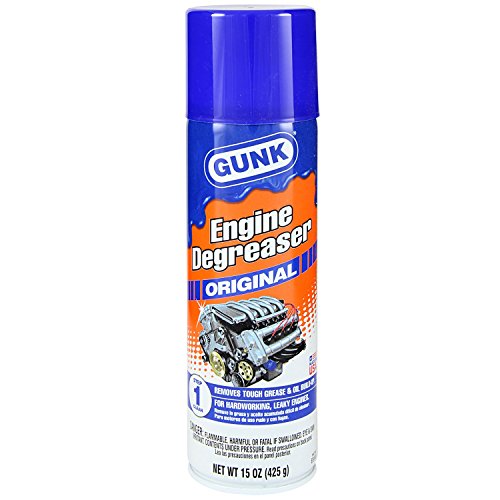Many car care enthusiasts swear by oven cleaner solutions as the best products to clean engines with. However, many car detailing professionals still recommend using proper engine degreasers for under-the-hood cleaning. So what is the difference between oven cleaners and engine degreasers? We've done the research for your convenience.
Although both engine degreasers and oven cleaners can clean up many engine parts, the two products differ in cleaning strength due to their respective chemical compositions. Oven cleaners are typically more harsh to rubber, plastic, and aluminum compared to most engine degreasers.
Would you like to find out more about the characteristics and possible usage of engine degreasers and oven cleaners for your car? Do read on, because we've prepared some juicy car care tips for you.
![cleaning oven in home kitchen - spraying a reagent on dirty inner surface of oven, Oven Cleaner Vs Engine Degreaser [What Is The Difference?]](https://vehq.com/wp-content/uploads/2022/09/8.-Oven-Cleaner-Vs-Engine-Degreaser.jpg)
Oven Cleaner VS Engine Degreaser
Both oven cleaners and engine degreasers are alkaline, or basic, solutions. Because of their relatively high pH levels, these solutions are effective in dissolving fats, oils, protein, and grease. In general, substances with pH levels higher than that of water (7) are good at cleaning this type of dirt.
Oven cleaners, however, are generally more alkaline than most engine degreasers. On the pH scale, oven cleaners usually have the highest pH levels (13 to 14). On the other hand, engine degreasers may have pH levels between 9 and 13.
The pH level difference may seem minuscule between the strongest degreasers and the common oven cleaner. However, the pH scale is logarithmic. This means that an oven cleaner (pH level 14) is 10 times stronger than even the most potent degreaser (pH level 13).
Many degreasers use sodium carbonate, otherwise known as washing soda, as the active ingredient. On the other hand, oven cleaners typically contain high concentrations of sodium hydroxide, commonly known as caustic soda or lye.
Most engine degreasers are weaker bases because the engine has plastic, rubber, and aluminum components. These engine parts are more sensitive to chemical damage than cast-iron engine blocks. You want to clean the engine, not destroy its parts.
Consequently, oven cleaners are stronger bases because they only need to clean the metal components inside ovens. Modern ovens typically use ceramic enamel-coated steel and stainless steel.
Both cleaning products are toxic substances, although water-based degreasers tend to be less so. Oven cleaner and oil-based degreaser fumes are poisonous and flammable, and even their droplets can be painful to human skin. Always use proper protective equipment when using these products.
Can Oven Cleaner Be Used As Engine Degreaser?
Oven cleaners are generally stronger cleaners than engine degreasers, but can you use oven cleaners to clean your engine?
The short answer is yes. However, be careful not to use oven cleaners on rubber, plastic, and aluminum engine parts.
Check out this popular oven cleaner on Amazon.
Moreover, oven cleaners can strip paint off your hood, engine bay, and body panels. Lye is even strong enough to ruin the highly durable engine enamel.
If you're trying to clean a completely disassembled engine out of your car, then yes, you can use an oven cleaner for the sturdy metal parts. However, if you're trying to clean your entire engine as well as your engine bay, then you're better off with a medium-strength cleaner-degreaser formula.
We're not saying that engine degreasers cannot damage engine parts as well. Some engine degreasers, especially when left to sit on the engine for a long time, can also ruin certain engine parts. Nevertheless, some engine degreasers are more effective than others.
What Is The Most Effective Engine Degreaser?
Despite having similar active ingredients, not all engine degreasers are made the same. Some degreasers can eat away at your paint while giving mediocre cleaning results. On the other hand, some degreasers can clean better while leaving little to no paint damage.
Here's a good video showing an actual experiment using different engine degreasers in a controlled setting. The experiment is a bit long, but the results are very convincing.
As we saw in the video, some degreaser brands are much more effective at dissolving sludges made out of several types of automotive fluids. Moreover, the best degreasers don't necessarily have to be the most expensive ones.
For your shopping convenience, here's one of the top-rated engine degreasers based on the experiment shown in the video.
Check out this popular and effective engine degreaser on Amazon.
How Do You Make A Homemade Engine Degreaser?
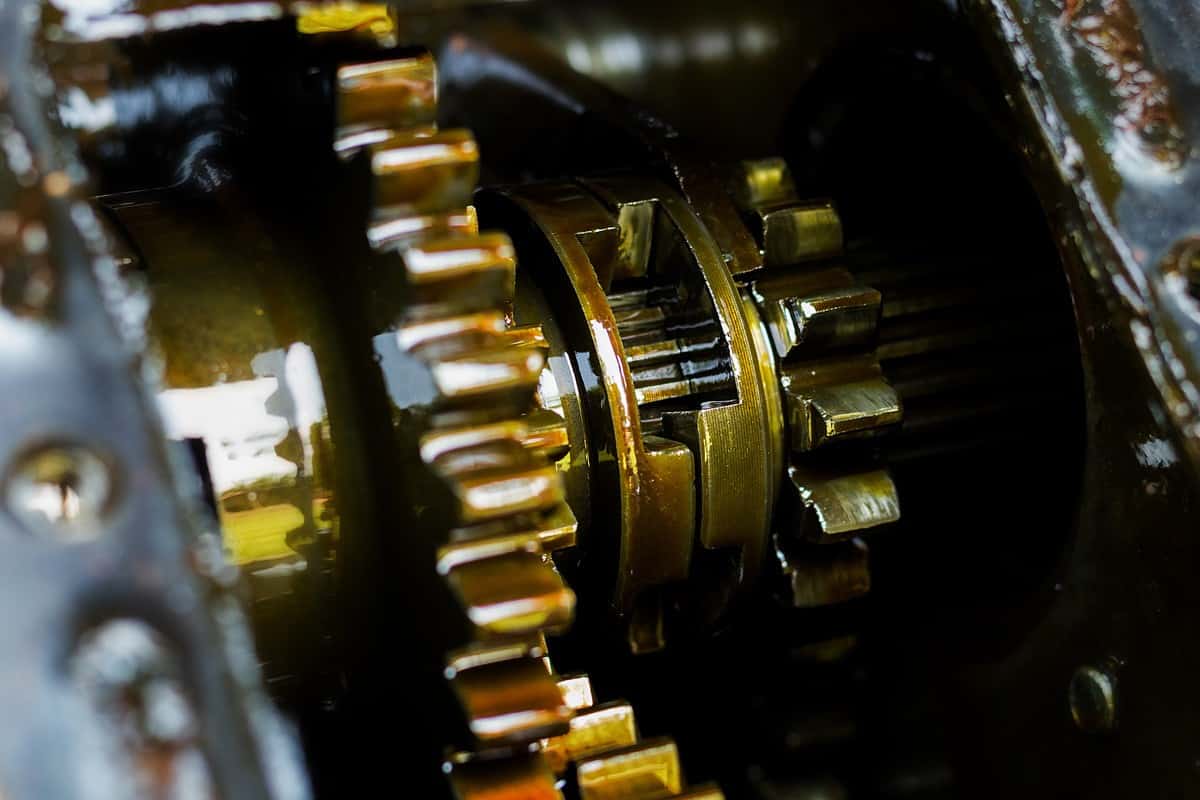
You can be eco friendly while saving a few dollars by making your own engine degreaser at home. You will need the following ingredients:
- 1 tablespoon of baking soda
- 1 teaspoon of lemon juice (pure, unsweetened)
- 1 cup of distilled white vinegar
- 1/4 cup of liquid soap (you can use dishwashing liquid)
- 1 cup water (you can use less or more, depending on how much you want to dilute the solution)
- 1 teaspoon of isopropyl alcohol
Mix all the ingredients in a glass or plastic bowl and stir well to get an even consistency. For a stronger solution, you may add some more baking soda and vinegar. If you wish to make a thicker degreaser, then you can add more liquid soap.
Check out this video on how to make a homemade engine degreaser solution:
What Is The Best Way To Clean A Car Engine?
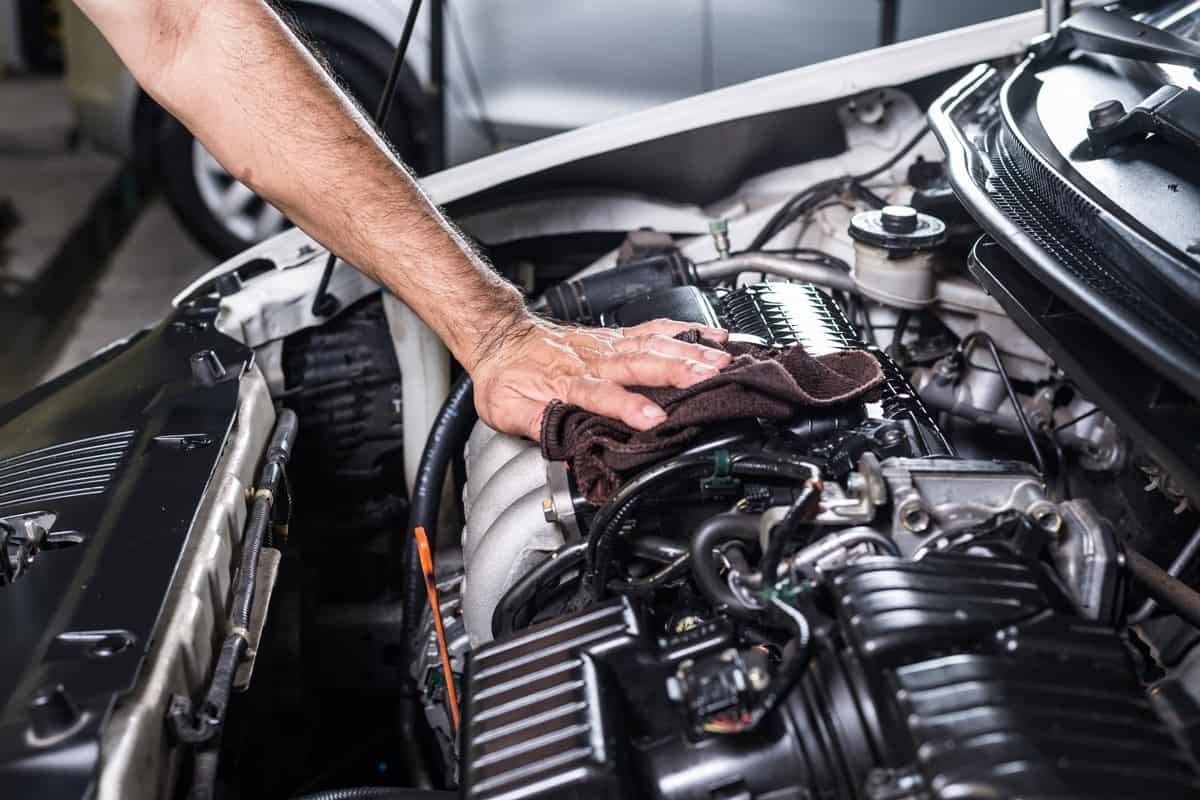
If your engine has survived several months or even years of use without any pampering, then you need a deep clean. For this project, you will need the following materials and tools:
- Microfiber towels (lots of them)
- Large plastic sheets (e.g. garbage bags)
- Vacuum cleaner
- Engine degreaser
- Wire brushes, soft brushes, toothbrushes, tube brushes, etc.
- Cleaning wipes (or clean cotton rags)
- Spray-on wax
- Plastic/rubber restorer
- Protective equipment (gloves, masks, goggles, or even garage coveralls)
- Screwdrivers and wrenches, as needed
Here are the main steps that you need to do for a good engine deep-cleaning.
Preparation For Cleaning
Before your engine cleaning project, you need to prepare yourself as well as your engine to make sure that the job will be safe and successful.
First, you will need to wear your protective equipment. You will be working with a lot of dust, dirt, caustic chemicals, sharp edges, and electrical circuits.
Second, you need to disconnect and remove your car's electrical power source—the battery—from the engine bay. Disconnecting the battery is fine, but removing it completely is much safer. Moreover, you can also clean more engine bay space as well as the battery's surfaces more thoroughly.
Third, you may want to remove some top engine parts that are blocking large areas of your engine and your engine bay. If you have a plastic engine cover, you may remove it to get better access to the engine itself. You may also remove the air intake assembly.
Fourth, you need to ensure that your engine is as watertight as possible. Make sure all plugs, caps, and connectors are firmly in place, like the distributor plugs, oil dipstick, transmission dipstick, etc.
Dry Cleaning
Your engine bay probably accumulated a lot of loose dust and debris, like leaves and twigs inside and around the engine bay. Grab all the bigger debris you can by hand, and use a vacuum cleaner for the dust and smaller pieces of dirt. Use different types of brushes to help the vacuum cleaner work more effectively.
Once done, make sure to cover up your fuse box, alternator, and air intake port with plastic sheets.
Wet Cleaning
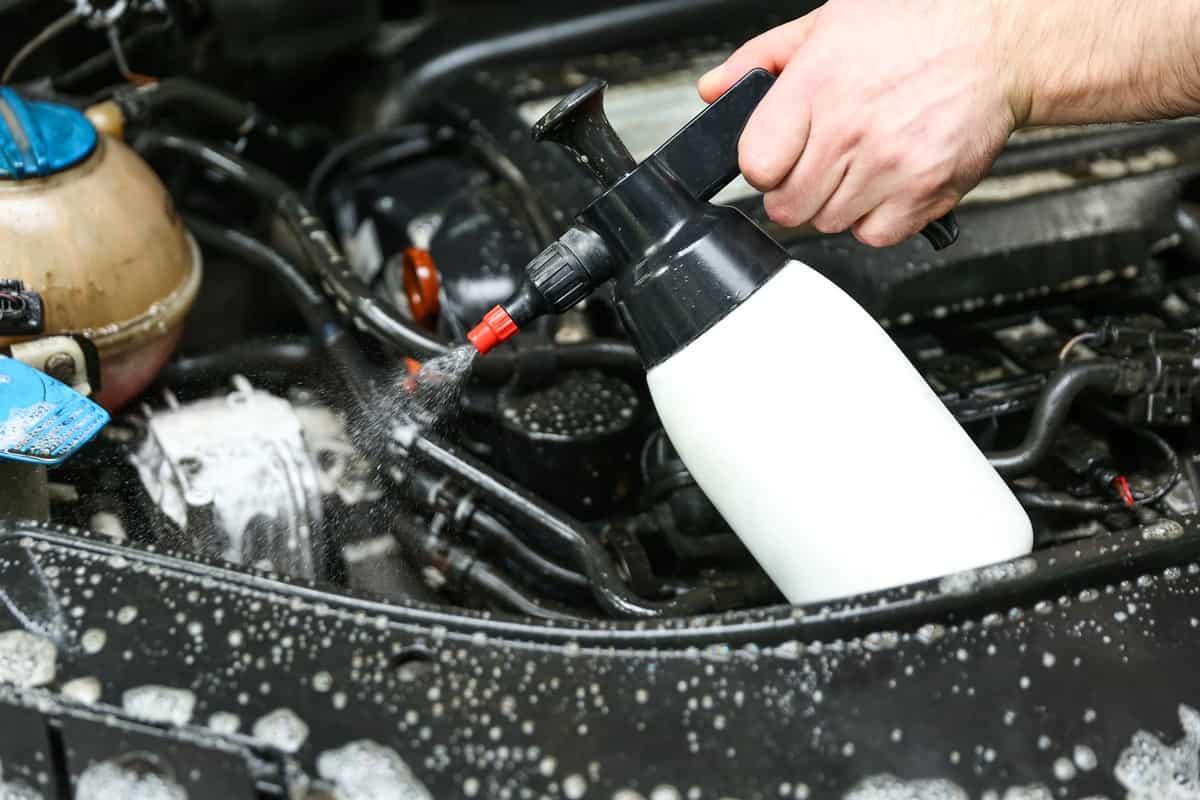
Wet cleaning involves water, and you can proceed to use your degreaser. To avoid damage from strong engine degreasers, work on one small area at a time. If you're using a milder all-purpose cleaner, then you can let the solution sit on large areas for longer periods of time.
Use the appropriate size and type of brush to agitate the caked-on dirt and grime. After scrubbing, wipe off the area, and check your results. Repeat the degreasing if needed, but make sure to rinse the area with water afterward.
Do the same process for the battery and engine parts that you took out of the engine bay.
Drying And Detailing
For safety reasons as well as the best cleaning results, make sure to dry your engine and engine bay well after rinsing. You can use your microfiber towels or pressurized air to help dry out any puddles or wells that have formed. While air drying, you can also use your restorer product on plastic engine parts.
Check out this video on how to clean your engine and engine bay well from the comfort of your own garage:
How Often Should You Clean Your Engine?
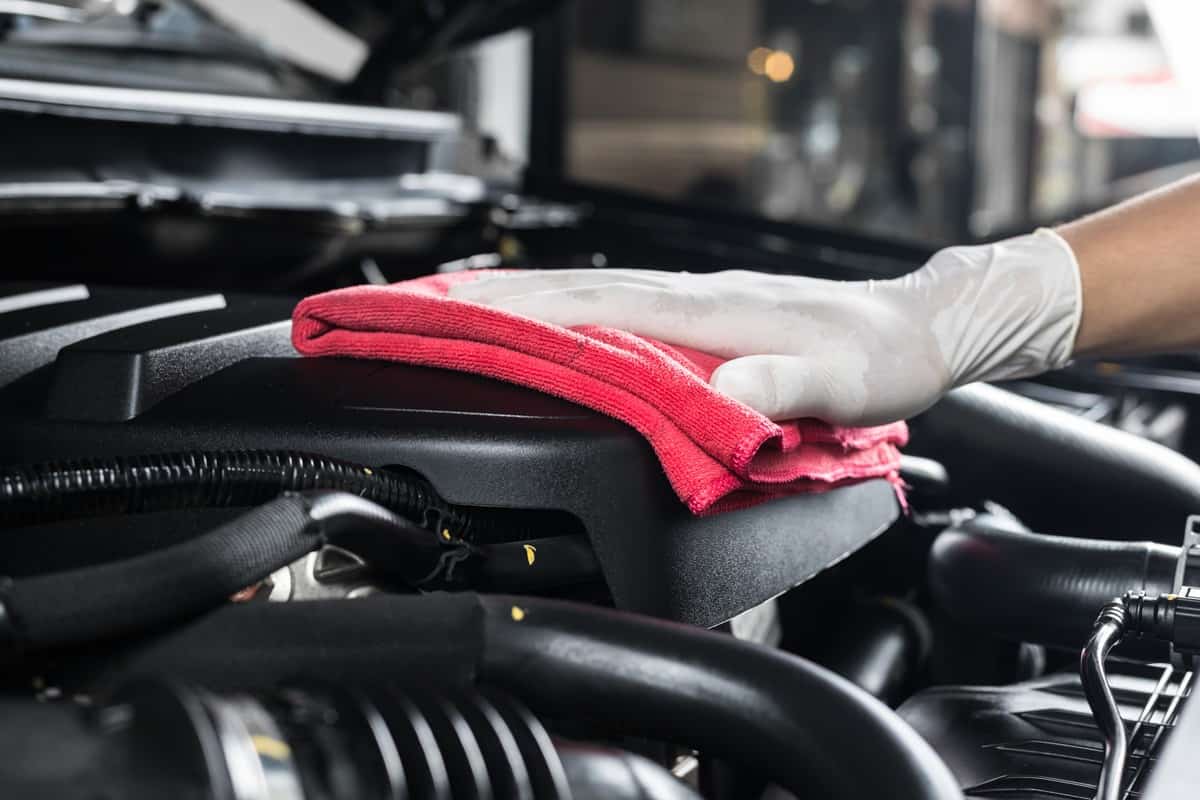
Engine cleaning is a more sensitive process compared to your regular carwash and cabin interior cleaning. Because of the caustic solution, the abrasive tools, and the water rinsing, you can easily damage several engine parts.
Nevertheless, you should not allow your engine to build up too much dirt and grime, as these contaminants can lead to poor engine cooling and even damage to engine parts. So how often should you deep-clean your engine?
In urban settings with minimal dustiness and snowfall, you can get away with an engine deep-clean once or at most twice a year. In very dusty, snowy, or rainy environments, you should clean the engine two to four times a year.
Wrapping Up
Oven cleaners and engine degreasers are both alkaline cleaning solutions that are effective in dissolving grease, oil, and other dirt that can accumulate in your engine. However, oven cleaners are typically much stronger chemicals that can damage rubber, plastic, paint, and even metal surfaces like aluminum.
Thank you very much for reading. We hope we were able to guide you on the differences between engine degreasers and oven cleaners.
For more interesting reads about engine detailing and other automotive topics, you may also check out these great articles below:
How To Remove Engine Enamel Paint


